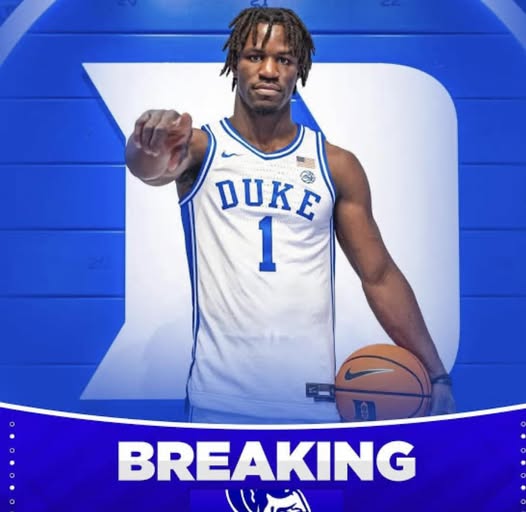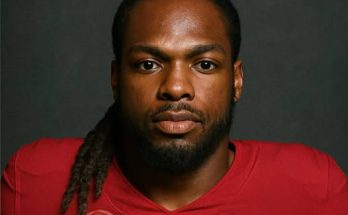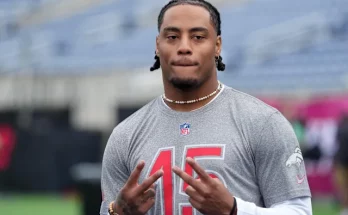In an era where college athletics have been radically transformed by Name, Image, and Likeness (NIL) deals, few decisions stand out like that of Duke’s rising star Sion James. The 6-foot-6 guard has stunned the basketball world not by the sheer size of a deal accepted, but by the magnitude of one turned down.
James, who recently signed a $15 million NIL agreement with various corporate sponsors aligned with Duke’s academic and athletic brand, was reportedly offered an eye-popping $25 million package by the University of Kentucky to transfer and lead the Wildcats next season. In a surprising move that sent shockwaves through the NCAA basketball landscape, James declined.
His reasoning? Loyalty.
“Duke is the object of my loyalty—this is home,” James told reporters following the announcement. “Money comes and goes. Legacy doesn’t.”
A Rare Decision in the NIL Era
Since NIL regulations changed in 2021, top-tier athletes have increasingly viewed their collegiate years not just as a stepping stone to the pros but as a way to build personal wealth early. Mega deals from collectives and sponsors have made the top programs even more competitive in securing talent—often resembling the free agency model of professional sports.
So when a talent like Sion James, who averaged 17.4 points, 6.8 rebounds, and 5.2 assists during the 2024–25 season, becomes available—even hypothetically—major programs take notice. Kentucky, known for its aggressive NIL campaigns and a deep-pocketed alumni base, reportedly constructed a deal worth $25 million over two years to entice James into transferring.
By all accounts, it was a deal James could have signed with a simple yes.
But he said no.
Why James Chose to Stay at Duke
Sion James’ commitment to Duke is rooted in something deeper than just a school affiliation—it’s part legacy, part brotherhood, and part unfinished business.
“My first visit to Cameron Indoor was when I was 15,” he said in an interview with The Players’ Journal. “There’s just something about Duke. It’s where I found my voice. It’s where I became a leader.”
For James, the development he’s experienced under the guidance of head coach Jon Scheyer and the Duke basketball family outweighed any financial incentive to leave. He cited Coach Scheyer’s belief in him, the fan support at Cameron Indoor, and the chance to compete for a national title with the teammates he’s grown alongside.
“There are things you just can’t put a dollar sign on,” James said. “I want to finish what we started.”
Reaction Around College Basketball
James’ decision was met with praise from both current and former players across the country. Even NBA stars chimed in on social media.
Former Blue Devil Jayson Tatum tweeted, “Loyalty in 2025? That’s rare. Respect, young king.”
Kentucky fans, meanwhile, were stunned—and perhaps a bit irritated. Wildcats message boards and social media lit up with debate, speculation, and frustration about how such a sizable offer could be turned down.
“I don’t get it,” one fan wrote on the popular UK message board Big Blue Banter. “This is a program that wins championships. How do you say no to $25 million and BBN?”
But for many in the Duke community, the decision only cemented James’ place in Blue Devils lore.
NIL Loyalty vs. NIL Leverage
James’ story underscores a growing tension in the NIL era: loyalty versus leverage. While NIL deals offer student-athletes long-overdue opportunities to monetize their brand, the flip side is the inevitable commodification of players.
Athletes are increasingly viewed as assets to be recruited, flipped, and re-recruited—sometimes even after signing. The transfer portal has become a revolving door, and loyalty often takes a back seat to opportunity.
James’ decision bucks that trend.
“It’s not about being anti-money,” said former Duke coach Mike Krzyzewski in a segment on ESPN’s College Gameday. “It’s about understanding what your name stands for. Sion gets that.”
Indeed, James has already earned significant NIL value. His latest $15 million deal includes partnerships with major brands such as American Express, Gatorade, and Beats by Dre, all of which have long-standing relationships with Duke and its storied athletic department. Unlike the Kentucky offer, which was largely fueled by private collectives, James’ current deal is seen as more sustainable and aligned with his brand off the court.
What This Means for Duke
James’ return sends a strong signal to both current and prospective players: Duke is still Duke.
With the 2025–26 season approaching, the Blue Devils are once again projected to be national title contenders. James will return as a senior leader and cornerstone of a lineup that includes Olivier Rioux, rising sophomore Caleb Foster, and incoming 5-star freshman Jabari Wallace.
More importantly, his decision gives Duke a unique recruiting advantage in an increasingly transactional world.
“This is a program that molds men, not just athletes,” said Coach Scheyer. “Sion’s loyalty speaks louder than any highlight reel.”
Inside the Kentucky Offer
While the specifics of Kentucky’s offer were never officially disclosed, multiple sources confirmed that the $25 million package included:
- A base NIL salary of $10 million annually.
- Equity opportunities in a Lexington-based tech startup founded by a UK alum.
- A luxury residence and car lease deal covered by an alumni-backed collective.
- Additional performance-based bonuses, including $1 million for an SEC championship and $2 million for a Final Four appearance.
The offer would have made James one of the highest-paid amateur athletes in history—surpassing even Bronny James’ projected earnings and matching the net value of some mid-tier NBA contracts.
Despite the incredible offer, James politely declined.
“Honestly, I was flattered,” James said. “Kentucky is a great program. But Duke is home. I didn’t come this far just to leave.”
The Bigger Picture
James’ story may become a benchmark moment in the NIL era, not because of the money involved, but because of the principle he stood on. In a time where athletes are encouraged to chase the highest bidder, James chose a different path.
Sports media figure Jay Bilas summed it up best:
“It’s easy to be loyal when things are comfortable. It’s harder when $25 million is on the table. What Sion James did is a reminder that loyalty isn’t dead—it’s just rare.”
That rarity, in turn, has become part of James’ growing legend at Duke. From his clutch shots in last season’s Elite Eight run to his emotional speech during Senior Night, Sion James is writing a story that will be remembered long after the NIL headlines fade.
Looking Ahead: The 2025–26 Season
With James leading the way, the Blue Devils enter the 2025–26 season as a top-3 team in most preseason polls. Expectations are sky-high, and with James back in the fold, Duke fans are dreaming big.
But perhaps more importantly, James’ return sets a tone—a tone of commitment, culture, and championship vision.
“He’s the heart of our team,” said Rioux. “He stayed. That means everything to us.”
Final Thoughts
In a world where $25 million can turn heads and shift destinies, Sion James stood still. Not for a lack of ambition, but for a belief in something greater than wealth—legacy, identity, and the sacred brotherhood that Duke basketball represents.
His choice won’t just define the next season—it may redefine how we talk about value in college athletics.
As James himself put it, “I’m not chasing money. I’m chasing banners.”
And with that kind of clarity, it’s no surprise that Blue Devils everywhere are standing a little taller today.



